RTLS tech Guide - Part 1
| Written by Mark Buzinkay
In eight chapters, we talk about the components and parts of RTLS, the diverse technologies used to create RTLS and how positioning works. But it’s not technology alone. More importantly, we illustrate use cases in theory and reality, ranging from container terminals and smart factories to the mining industry.
We hope this introduction will stimulate you to continue your investigation into this topic and, eventually, assist you in executing your transition to a semi- or fully-automated process for greater productivity and less waste.
This is part 1 of 3 - if you want to download the entire eBook, scroll down to the end of the article.

No video selected
Select a video type in the sidebar.
(1) Understanding RTLS: basic principles of technology
Real-time Location Systems (RTLS) is a powerful technology that is being rapidly adopted across multiple industries. It is a way of tracking the exact location of people, assets, and other objects in real-time. In this section, we will discuss the fundamentals of RTLS, its components and its application areas. We will also discuss the basics principles of RTLS technology, how it works and how it can be used to tag people. By the end of this article, you should have a clearer understanding of RTLS and its potential applications.
(1.1) What is RTLS?
Real-Time Location Systems (RTLS) is a technology that allows the tracking of the position of objects in real-time. It helps in monitoring the whereabouts of people or items, enabling businesses to make better decisions that improve safety, increase efficiency, and reduce costs.
To understand how RTLS works, you first need to understand the term “real-time.” Real-time refers to the ability to get data immediately as it's happening. The system keeps track of the exact location of something and updates the tracking information in real-time. This means it's always current and precise.
RTLS typically uses radio frequency (RF) signals, such as Wi-Fi, Bluetooth, or Ultra-Wideband (UWB) technology, to locate and track people, items, and assets. Each item is outfitted with a tag or sensor that transmits radio signals. The radio signals are then picked up by an array of receivers placed throughout the area being monitored. The receivers triangulate the signals and are able to pinpoint the exact location of each item.
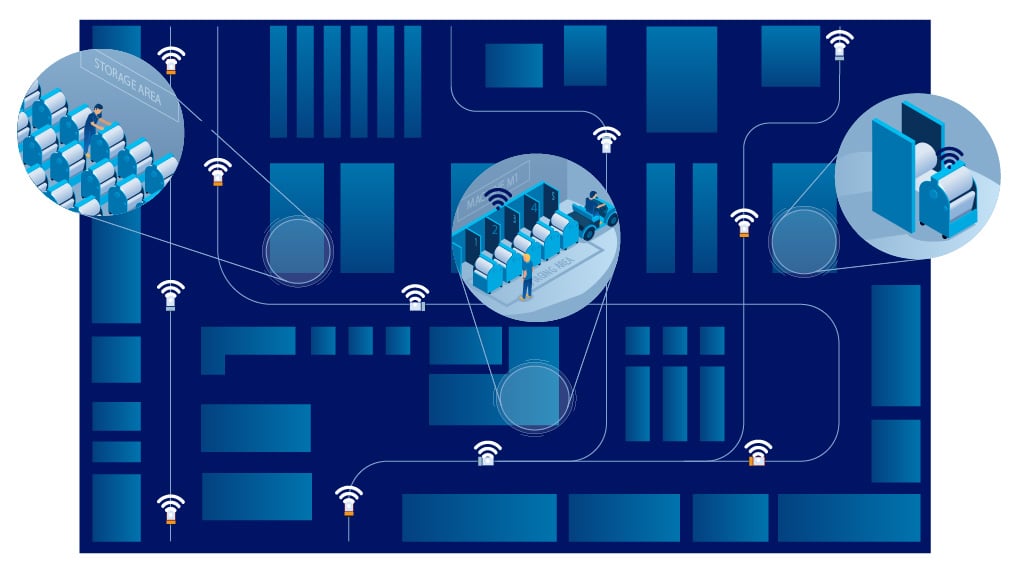
The technology can be used in a variety of applications, from healthcare to manufacturing. By being able to track the exact location of medical equipment, personnel, and patients within a hospital, healthcare providers can improve patient safety and maximize efficiency. In a manufacturing environment, RTLS can be used to improve asset utilization and accuracy in the supply chain.
In addition to the hardware components, RTLS software is used to store and analyse the data collected. This data can then be used to generate reports and insights to improve operations further.
RTLS is an increasingly popular technology, as it can improve safety, increase efficiency, and reduce costs, making it an invaluable tool for businesses of all sizes.
(1.2) Basic Principles of RTLS Technology
Real-Time Location Systems (RTLS) is an emerging technology that uses a combination of different sensors and tracking systems to identify, locate, and track the position of a physical object or person in real-time. This technology is designed to provide precise positioning data, allowing for greater insight into the behaviour of different objects and people, as well as their respective locations. RTLS technology is extremely versatile and can be used in a variety of applications.
In most RTLS deployments, a wireless network of sensors, tags, and receivers is used to monitor the environment and detect the presence and movement of objects. When an object is detected, the RTLS system is able to identify its position and provide accurate location data.
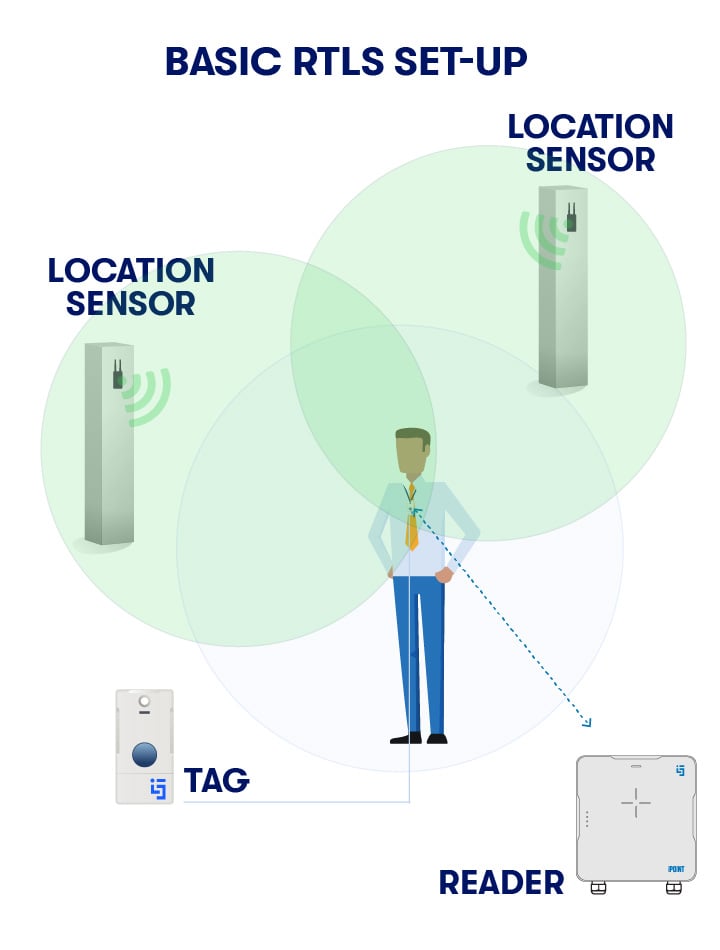
The basic principles of RTLS technology involve the use of radio waves to transmit tracking information between tags, sensors, and receivers. Radio waves are emitted from transmitters such as tags and sensors, which are often located on objects or people that are being tracked. These radio waves are received by receivers, which are usually located within a defined area. The receivers then process the received signal to calculate the exact position of the object or person being tracked.
The accuracy of RTLS systems is dependent on the quality of the radio waves being used, the number of transmitters and receivers, and the environment in which the system is deployed. Additionally, the accuracy of RTLS systems may also be affected by obstacles between the transmitter and receiver, as well as interference from other wireless signals.
In conclusion, the basic principles of RTLS technology involve the use of radio waves to transmit tracking information between tags, sensors, and receivers. The accuracy of the system is highly dependent on the quality of the radio waves and the number of transmitters and receivers. Additionally, obstacles and other wireless signals may cause interference and affect the accuracy of the system. RTLS technology can be used in a variety of applications, allowing for precise positioning data and a greater insight into the behaviour of different objects and people.
Tagging People
When it comes to the latest RTLS (Real-Time Location System) technology, tagging people is just one of the many exciting applications it can be used for.
When tagging people with RTLS, special tags or transponders are attached to individuals. These tags or transponders have the form of badges, wristbands, ankle bands, belt clips or clips on the helmet. They can then be used to track and monitor their movement throughout the area. By utilizing an RTLS system, businesses are able to locate their employees, visitors, and customers, providing an innovative way to increase safety, efficiency, and productivity.
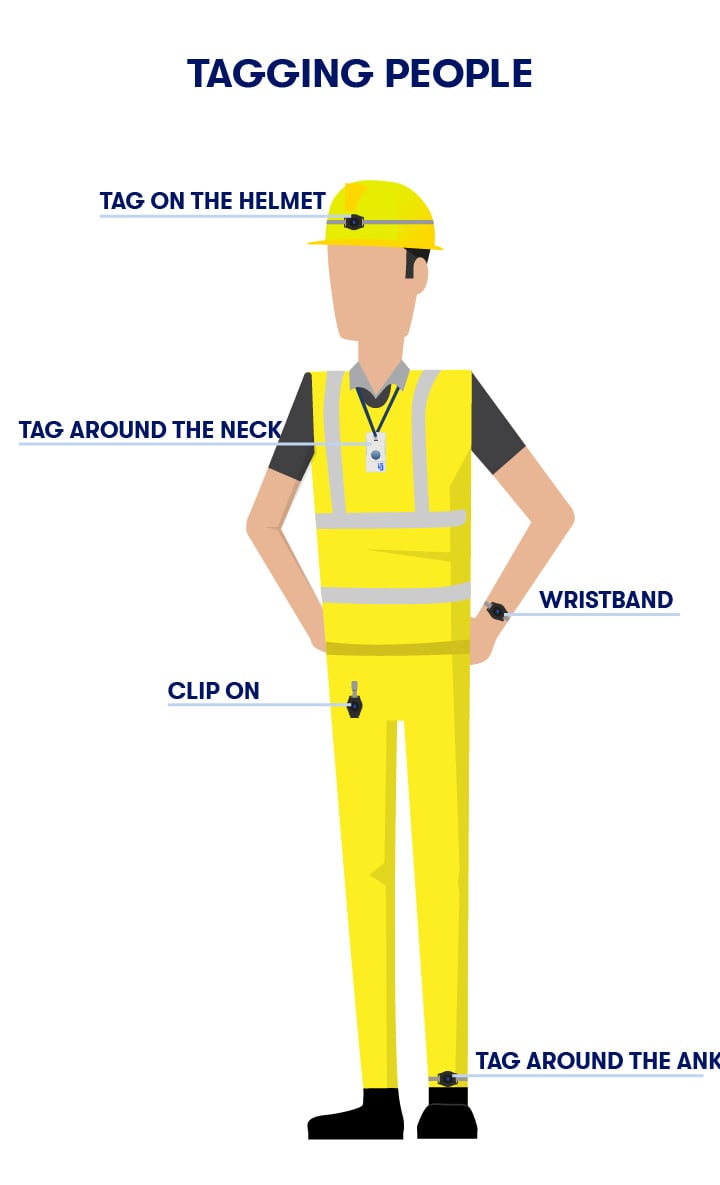
One of the primary advantages of tagging people with an RTLS system is the ability to detect emergency situations. If a visitor is lost or can’t be found, the RTLS system can pinpoint their exact location within the facility. This can help emergency personnel find people quickly and efficiently, ensuring the safety of everyone in the area.
Another advantage of using RTLS to tag people is in the realm of customer service. Businesses can provide better customer service by using the RTLS system to track customers. For instance, companies can use the system to track customers’ movements throughout the facility, ensuring they always have timely service. Customers can be notified when their order is ready or when specific products are available, as well as other personalized notifications.
Finally, tagging people with RTLS is beneficial for security measures. With the RTLS system, businesses can easily identify and track suspicious individuals. This can help protect employees and customers from potential threats and unwanted intruders.
Tagging people with RTLS is a great way to increase safety, efficiency, and customer service. By leveraging this innovative technology, businesses, organizations, and communities can easily stay connected, track important movements, and promote a secure atmosphere.
Tagging assets
Real-time locating systems are used to track and manage workplace physical assets. RTLSs are typically used in industrial, warehouse, and medical settings and allow for precise inventory, equipment, personnel, and other resource tracking. RTLSs typically involve affixing tags to assets, which are then monitored by a network of readers and sensors linked to a centralized database.
The system works by having tags attached to relevant objects and tracking the tags’ movements through the readers spread throughout the workplace. The readers detect the tags when they are nearby, which allows for detailed tracking of the object’s location. The tags are typically powered by radio waves, and the tags communicate with the sensors using a variety of radio frequency (RF) technologies. This helps the system pinpoint the precise location of the tag, and the information is relayed back to the centralized database.
In addition to providing the precise location of the tag, RTLSs can also provide additional data such as temperature, humidity, battery life, and more. This data can then be used to optimize workplace efficiency and safety. For example, if a region is experiencing high temperatures, the RTLS can provide the data to ensure that workers are operating in safe conditions.
In addition to its tracking capabilities, RTLS is also used for asset management and inventory control. By tagging assets and tracking them through the system, businesses can closely monitor the location and condition of their assets in real time. Very often, equipment easily goes missing, especially on larger sites (like a hospital or factory). RTLS helps businesses better manage their (tagged) assets and inventory, leading to improved resource utilization and greater efficiency. Furthermore, it provides information where the asset has been in the past.
Overall, RTLS is an essential technology for businesses that need to monitor assets or personnel in the workplace closely. By affixing tags to relevant objects, businesses can use the RTLS system to precisely track their assets in real time and provide detailed data to optimize workplace safety and efficiency.
Want more? Continue reading about RFID for asset tracking.
(1.3) RTLS Use cases in industries
RTLS is an increasingly popular technology being adopted in a variety of industries. The global RTLS market size increased from $7.13 billion in 2022 to $9.2 billion in 2023 at a compound annual growth rate (CAGR) of 29.1% (1). Companies are using RTLS technology to improve efficiency, reduce costs, and improve the quality of service. RTLS technology is also being used to improve safety, optimize workflows, and even in personnel tracking. RTLS technology can be used in retail, manufacturing, healthcare, logistics, and more.
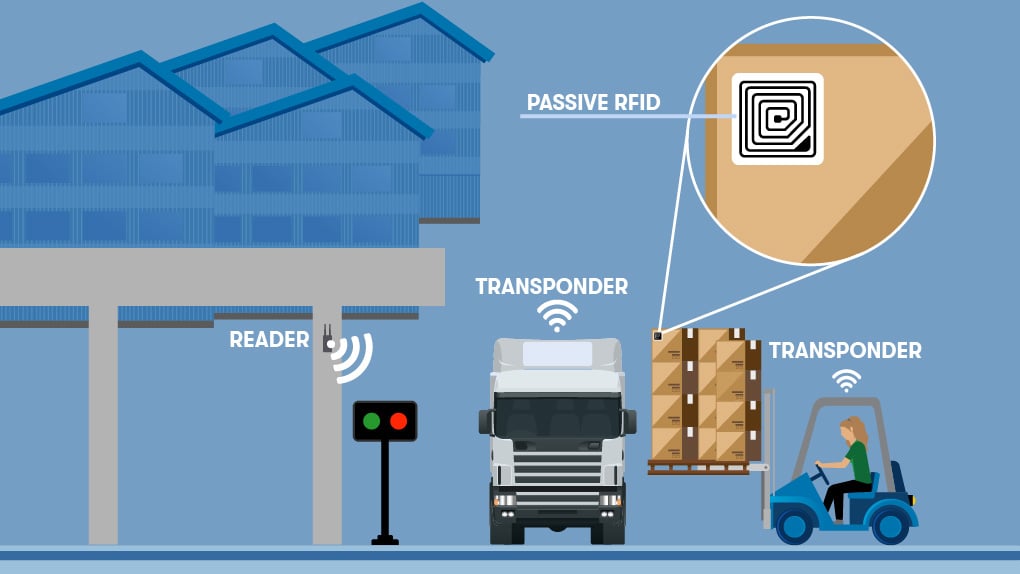
In retail, there are many ways that retailers can utilize RTLS to improve their operations. For example, some retailers have deployed RTLS to track where customers go in the store or to identify slow-moving products that need to be moved or discounted. Additionally, some retailers have used RTLS to track merchandise as it moves through the supply chain, reducing losses and improving customer service.
In manufacturing, RTLS solutions trace the production process, track batches of material (2), and optimize production flow. For example, valuable time is lost because the material container needed for the next production step isn't where it should be, and a search must follow. A tagged container can be easily located, reducing search time considerably. Another way to use RTLS in manufacturing is tagging work orders. They enable us to locate at what stage of manufacturing that specific work order is (Volkswagen Wolfsburg is applying this technique to the finishing steps of their soon-to-be-delivered cars).
In healthcare, RTLS systems improve patient safety, automate medication administration, improve staff efficiency, and reduce asset loss and theft. RTLS technology can also be used to locate staff and patients in extensive facilities, such as hospitals, and to track and manage medical equipment.
In logistics, RTLS technology is used to track and monitor the delivery of goods and services. RTLS systems monitor the location and status of shipments, track driver and vehicle performance, monitor asset utilization and temperatures and prevent theft and tampering.
RTLS can also be used for workplace safety and security. For example, some organizations have implemented RTLS to monitor employee movements in hazardous or secure areas, or to ensure that the unused equipment is kept away from dangerous areas. RTLS monitors the progress of work in difficult or hazardous conditions, such as mining and tunnel construction.
Restaurants, hotels, and other hospitality businesses can also benefit from an RTLS solution. RTLS quickly locates items such as linens, dishes, and cleaning supplies, reducing time-consuming searches and improving efficiency. RTLS can also be used to track staff movements and reduce the time it takes to serve customers.
Overall, RTLS technology has a wide range of use cases in industries across the world - automotive, aerospace, research, retail, healthcare, manufacturing, mining, conferences and events, public safety and education. Organisations of all sorts are increasingly turning to this technology to improve their operations and reduce their costs according to lean practices (3).
(1.4) Case study Volkswagen Wolfsburg
Wolfsburg's futuristic and iconic Autostadt (“car city”) is nothing less than a stage for celebrating the motor vehicle. Fans and customers experience an automotive world in a league of its own, right next door to one of Germany´s largest car factories and Volkswagen’s main plant. The Wolfsburg plant is a complex system of more than 60,000 workers and employees assembling and finishing individual cars in a myriad of intricate steps, in the midst of which Asset Agent and real-time location play a little-known but significant role.
Want more? Read about locating vehicles in a car park.
(2) RTLS Basic components and parts
Real-time location systems (RTLS) are a game-changing type of location-based system. They utilize active RFID tags, readers, and other cutting-edge equipment to provide real-time tracking of objects, people, and materials. With the ability to offer visibility and insight into operational processes while dramatically reducing operational costs, it's no wonder that RTLS has found its way into a wide range of industries, including healthcare, retail, and manufacturing.
The basic components of an RTLS system are tags, readers and a centralized software platform.
Tags are small tracking devices that are attached to or embedded within objects or people. Active RFID tags are the most commonly used type of tag in RTLS systems, as they provide a reliable and accurate means for tracking. Tags come in a variety of shapes and sizes and may contain built-in sensors for additional data collection.
Readers are devices that capture information from the tags and then transmit the data to the software platform. They are typically installed on walls, poles, or other fixed locations and can scan the tags in the vicinity and relay the information back to the central software platform.
The software platform is the system that manages, processes, and stores the data collected by the readers. It is where data is gathered, analysed, and visualized so it can be used to make well-informed decisions. The platform can also be configured to send out alerts when something unexpected or out of the ordinary occurs.
(2.1) Tags
Tags are an essential part of any RTLS. They are small tracking devices that can be attached to objects or people, allowing for pinpoint accuracy and continuous data collection. In addition to helping users track the exact location of an object or person, tags can also provide other valuable information such as temperature, humidity, pressure, and vibration levels. Using tags with RTLS systems makes it easy to monitor and manage these conditions remotely. Furthermore, tags can also be used to trigger certain actions like triggering alarms if certain conditions are met. With this capability, users can set up customized notifications and alerts that will help them keep their properties, personnel, and operations secure.
The tag emits a signal that is picked up by a network of receivers located throughout the tracking area, known as sensors, satellites or beacons. The sensors then triangulate the tag's position to determine its exact location.
Passive tags receive the signal via their antennas and then respond by transmitting their stored data. As they don't have a battery, they obtain the operational power from the RF field emitted by a corresponding interrogator. That's why their range is limited (to about 10 meters).
Semi-passive tags have their own battery but don't initiate any communication like the passive tag. The battery provides a greater range or monitors environmental conditions.
Active RTLS tags use their own battery and communicate without being prompted, so they can be located in real time. The critical component is the battery (life). The way the battery is used (interval, strength, etc.) determines its lifetime.
Tags are also often used in conjunction with other technologies for more comprehensive tracking capabilities. By combining different technologies into one system, organizations can monitor their assets more effectively and ensure compliance with regulations.
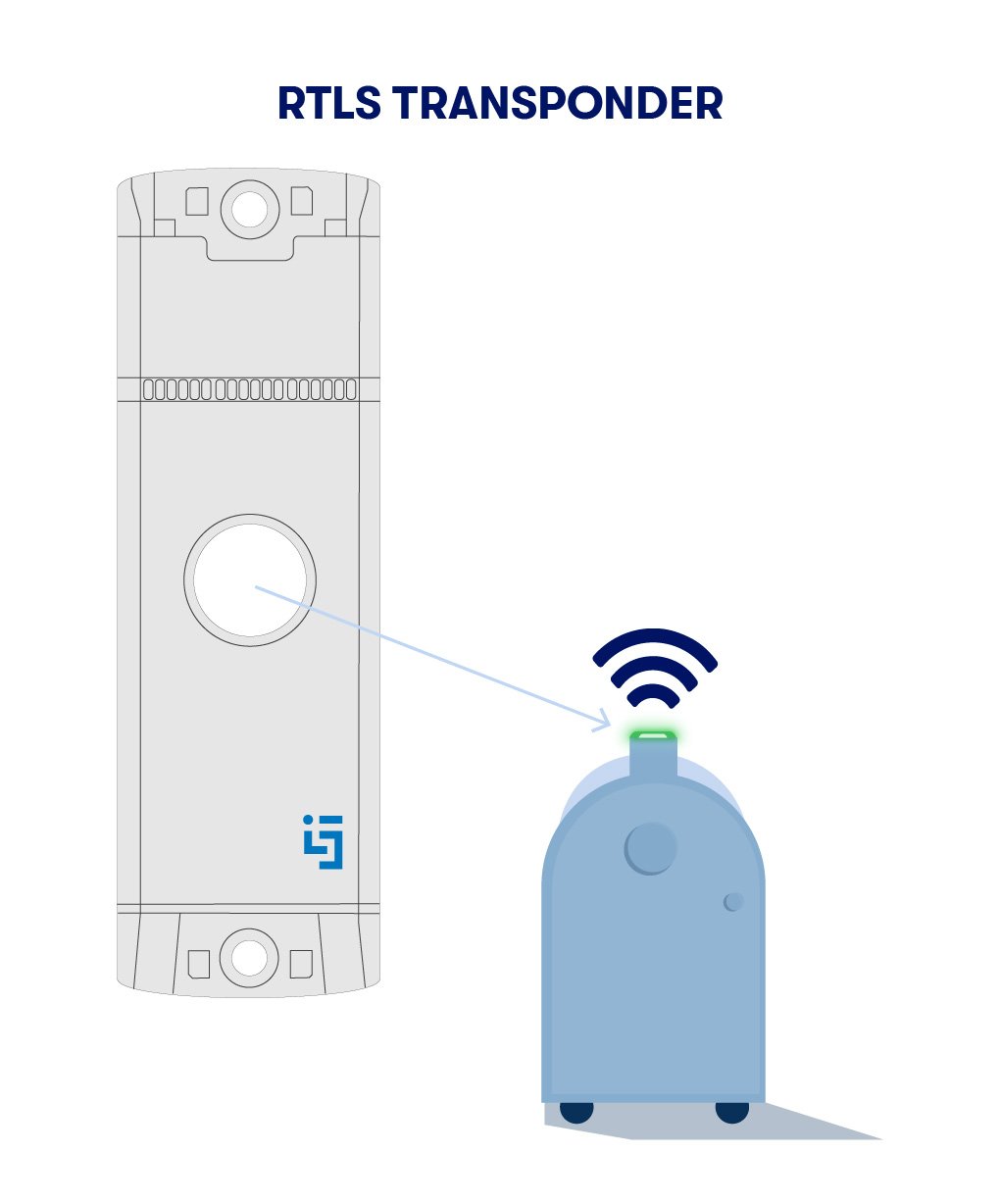
(1.2) Readers
Readers are an essential component of a Real-Time Location System (RTLS). They gather location data from tags or other types of sensors and transmit it to the system. Readers come in many different shapes and sizes, depending on the intended application. They can range from small, low-power, battery-powered readers that can be placed anywhere in a facility to more sophisticated readers that require external power and can be mounted on walls or ceiling grids.
The most common type of RTLS reader is a “fixed reader”, which is permanently installed in a designated location and wirelessly communicates with tags or sensors to gather data. The advantage of fixed readers is that their coverage area can be well controlled since they only need to cover the area directly around them.
Another type of reader is a mobile reader, which is typically used for wide-area applications such as tracking assets in large warehouses or outside locations. Mobile readers are often battery-powered and can move freely around an area to track moving assets.
Finally, there are special readers designed for specific use cases, such as underwater asset tracking or long-range tag reading. These readers offer special features such as increased sensitivity, waterproofing, and extended range to meet the needs of their respective applications.
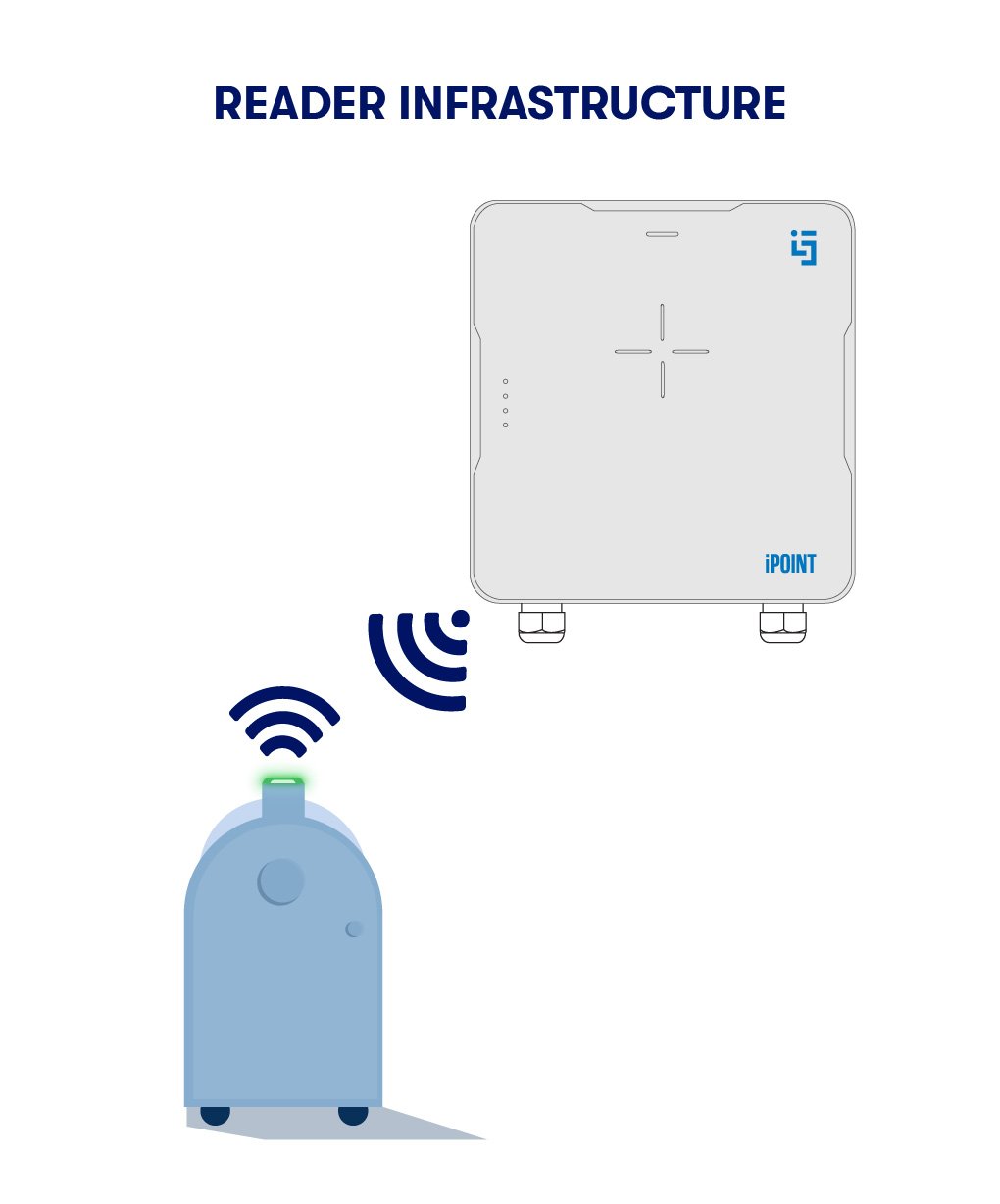
(1.3) Network Infrastructure
Real-time locating systems (RTLS) rely on a network infrastructure to collect and transmit data from tags, which are typically worn by people or attached to objects. The network infrastructure is composed of three components: tags, readers, and a control system.
Tags transmit data to the reader. They may be active or passive and come in different shapes, such as a tag attached to an item or a wearable bracelet. Tags can also be programmed with specific settings such as location tracking, alerting, and data collection.
Readers are the devices that receive data from the tags. They usually contain radio transceivers that enable them to communicate with the tags over a certain frequency range. Readers are typically installed in fixed locations throughout the area being monitored, such as along hallways or near doorways. For pin-pointing, sensors are added to the network to provide location reference.
The control system is responsible for managing all aspects of the RTLS application, including data collection, analysis, and reporting. It typically consists of a computer server connected to readers via some form of communication network (e.g., Wi-Fi). The control system also includes software for storing and analyzing collected data.
KEY TAKEAWAYS FROM These CHAPTERS
- Tags are an essential part of any RTLS. They are small tracking devices that can be attached to objects or people, allowing for pinpoint accuracy and continuous data collection.
- Active tags use their own battery and communicate without being prompted (like passive tags).
- Readers are responsible for gathering location data from tags or other types of sensors and transmitting it to the system.
- The network infrastructure is composed of several components like tags, readers, satellites and a control system.
And now continue with the second part of our eBook or download the entire eBook as pdf below.
Dive deeper into one of our core topics: Real time locating system
Glossary
Compound Annual Growth Rate (CAGR) measures the mean annual growth rate of an investment over a specified time period, assuming profits are reinvested at the end of each year. It is calculated using the formula:

where nnn is the number of years. CAGR is widely used for comparing performance across investments or tracking consistent growth trends. (5)
References:
(1) https://www.thebusinessresearchcompany.com/report/real-time-location-systems-global-market-report
(2) J. Slovák, P. Vašek, M. Šimovec, M. Melicher and D. Šišmišová, "RTLS tracking of material flow in order to reveal weak spots in production process," 2019 22nd International Conference on Process Control (PC19), Strbske Pleso, Slovakia, 2019, pp. 234-238, doi: 10.1109/PC.2019.8815220.
(3) Nowotarski, P.; Pasławski, J.; Skrzypczak, M.; Krygier, R.: RTLS systems as a Lean Management tool for productivity improvement. In: ISARC. Proceedings of the International Symposium on Automation and Robotics in Construction; Waterloo Vol. 34, : IAARC Publications. (2017): 1-8.
(4) Augustin, A., Yi, J., Clausen, T., & Townsley, W. M. (2016). A Study of LoRa: Long Range & Low Power Networks for the Internet of Things. Sensors, 16(9), 1466.
(5) Damodaran, A. (2012). Investment Valuation: Tools and Techniques for Determining the Value of Any Asset. Wiley.
Note: This article has been updated on the 29th of July 2025. It was partly created with the assistance of artificial intelligence to support drafting.

Author
Mark Buzinkay, Head of Marketing
Mark Buzinkay holds a PhD in Virtual Anthropology, a Master in Business Administration (Telecommunications Mgmt), a Master of Science in Information Management and a Master of Arts in History, Sociology and Philosophy. Mark spent most of his professional career developing and creating business ideas - from a marketing, organisational and process point of view. He is fascinated by the digital transformation of industries, especially manufacturing and logistics. Mark writes mainly about Industry 4.0, maritime logistics, process and change management, innovations onshore and offshore, and the digital transformation in general.
Related Articles
Related Product




